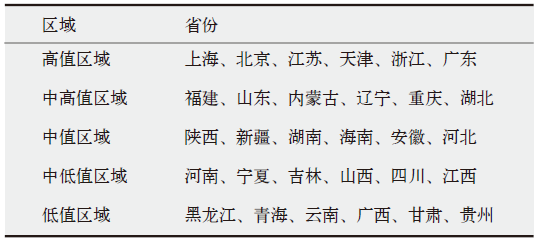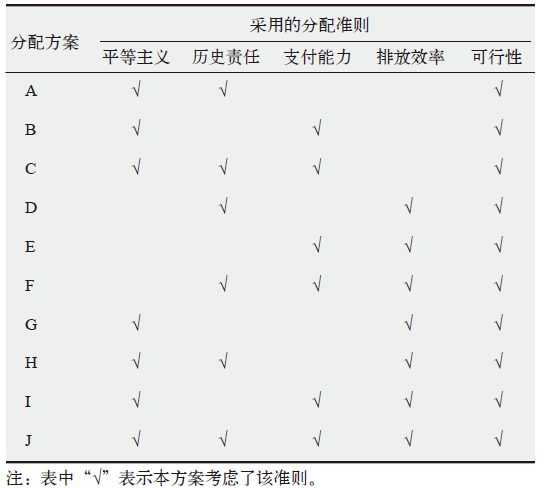| [1] |
Chen B, Zhang H, Li W, et al. Research on provincial carbon quota allocation under the background of carbon neutralization[J]. Energy Reports, 2022, 8: 903-915
|
| [2] |
Fang K, Zhang Q, Long Y, et al. How can China achieve its intended nationally determined contributions by 2030? A multi-criteria allocation of China’s carbon emission allowance[J]. Applied Energy, 2019, 241: 380-389
doi: 10.1016/j.apenergy.2019.03.055
|
| [3] |
王文举, 孔晓旭. 基于2030年碳达峰目标的中国省域碳配额分配研究[J]. 数量经济技术经济研究, 2022, 39 (7): 113-132.
|
|
Wang W J, Kong X X. Analysis on China’s provincial carbon quota allocation based on the 2030 carbon peak goal[J]. The Journal of Quantitative & Technical Economics, 2022, 39 (7): 113-132 (in Chinese)
|
| [4] |
He W J, Zhang B, Li Y X, et al. A performance analysis framework for carbon emission quota allocation schemes in China: perspectives from economics and energy conservation[J]. Journal of Environmental Management, 2021, 296: 113165
|
| [5] |
林洁, 祁悦, 蔡闻佳, 等. 公平实现《 巴黎协定》目标的碳减排贡献分担研究综述[J]. 气候变化研究进展, 2018, 14 (5): 529-539.
|
|
Lin J, Qi Y, Cai W J, et al. A review on the studies of equitable sharing in national mitigation contributions to achieve the Paris Agreement ambitions[J]. Climate Change Research, 2018, 14 (5): 529-539 (in Chinese)
|
| [6] |
何建坤, 陈文颖, 滕飞, 等. 全球长期减排目标与碳排放权分配原则[J]. 气候变化研究进展, 2009, 5 (6): 362-368.
|
|
He J K, Chen W Y, Teng F, et al. Long-term climate change mitigation target and carbon permit allocation[J]. Climate Change Research, 2009, 5 (6): 362-368 (in Chinese)
|
| [7] |
Zhou P, Wang M. Carbon dioxide emissions allocation: a review[J]. Ecological Economics, 2016, 125: 47-59
|
| [8] |
熊小平, 康艳兵, 冯升波, 等. 碳排放总量控制目标区域分解方法研究[J]. 中国能源, 2015, 37 (11): 15-19.
|
|
Xiong X P, Kang Y B, Feng S B, et al. Research on method for regional decomposition of carbon emission cap[J]. Energy of China, 2015, 37 (11): 15-19 (in Chinese)
|
| [9] |
Zhou H, Ping W, Wang Y, et al. China’s initial allocation of interprovincial carbon emission rights considering historical carbon transfers: program design and efficiency evaluation[J]. Ecological Indicators, 2021, 121: 106918
|
| [10] |
Li Z, Zhao T, Wang J, et al. Two-step allocation of CO2 emission quotas in China based on multi-principles: going regional to provincial[J]. Journal of Cleaner Production, 2021, 305: 127173
|
| [11] |
Tian M, Hu Y J, Wang H, et al. Regional allowance allocation in China based on equity and efficiency towards achieving the carbon neutrality target: a composite indicator approach[J]. Journal of Cleaner Production, 2022, 342: 130914
|
| [12] |
Li F, Wu F, Chen L. Harmonious allocation of carbon emission permits based on dynamic multiattribute decision-making method[J]. Journal of Cleaner Production, 2020, 248: 119184
|
| [13] |
滕飞, 何建坤, 潘勋章, 等. 碳公平的测度: 基于人均历史累计排放的碳基尼系数[J]. 气候变化研究进展, 2010 (6): 449-455.
|
|
Teng F, He J K, Pan X Z, et al. How to measure carbon equity: carbon Gini index based on historical cumulative emission per capita[J]. Climate Change Research, 2010 (6): 449-455 (in Chinese)
|
| [14] |
Yang Y, Yang S. Are industrial carbon emissions allocations in developing regions equitable? A case study of the northwestern provinces in China[J]. Journal of Environmental Management, 2020, 265: 110518
|
| [15] |
He W, Zhang B. A comparative analysis of Chinese provincial carbon dioxide emissions allowances allocation schemes in 2030: an egalitarian perspective[J]. Science of The Total Environment, 2021, 765: 142705
|
| [16] |
Pan X, Teng F, Wang G. A comparison of carbon allocation schemes: on the equity-efficiency tradeoff[J]. Energy, 2014, 74: 222-229
|
| [17] |
贺晓宇, 沈坤荣. 现代化经济体系, 全要素生产率与高质量发展[J]. 上海经济研究, 2018 (6): 25-34.
|
|
He X Y, Shen K R. modernized economic system, total factor productivity and high quality development[J]. Shanghai Journal of Economics, 2018 (6): 25-34 (in Chinese)
|
| [18] |
刘志彪, 凌永辉. 结构转换, 全要素生产率与高质量发展[J]. 管理世界, 2020, 36 (7): 15-28.
|
|
Liu Z B, Ling Y H. Structural transformation, TFP and high-quality development[J]. Journal of Management World, 2020, 36 (7): 15-28 (in Chinese)
|
| [19] |
蔺鹏, 孟娜娜. 环境约束下京津冀区域经济发展质量测度与动力解构: 基于绿色全要素生产率视角[J]. 经济地理, 2020, 40 (9): 36-45.
|
|
Lin P, Meng N N. Quality measurement and dynamic deconstruction of regional economic development in Beijing-Tianjin-Hebei region under environmental constraints: from the perspective of green total factor productivity[J]. Economic Geography, 2020, 40 (9): 36-45 (in Chinese)
|
| [20] |
高文鞠, 綦良群. 科技人才, 全要素生产率与装备制造业高质量发展[J]. 中国科技论坛, 2020, 1 (9): 84-95.
|
|
Gao W J, Ji L Q. S&T talents, TFP and high-quality development of equipment manufacturing industry[J]. Forum on Science and Technology in China, 2020, 1 (9): 84-95 (in Chinese)
|
| [21] |
Wei Y M, Wang L, Liao H, et al. Responsibility accounting in carbon allocation: a global perspective[J]. Applied Energy, 2014, 130: 122-133
|
| [22] |
Solow R M. Technical change and the aggregate production[J]. The Review of Economics and Statistics, 1957, 39 (3): 312-320
|
| [23] |
孙欣, 姜坷, 段东. 长江经济带高质量发展效率测度[J]. 统计与决策, 2022 (1): 118-121.
|
|
Sun X, Jiang K, Duan D. Measurement of high quality development efficiency in the Yangtze River economic belt[J]. Statistics & Decision, 2022 (1): 118-121 (in Chinese)
|
| [24] |
王家明, 余志林. 沿黄地区中心城市及城市群高质量发展的测度及影响因素[J]. 中国人口·资源与环境, 2021, 31 (10): 47-58.
|
|
Wang J M, Yu Z L. Measurement and influencing factors of high-quality development of the central cities and urban agglomerations along the Yellow River[J]. China Population, Resources and Environment, 2021, 31 (10): 47-58 (in Chinese)
|
| [25] |
余泳泽, 杨晓章, 张少辉. 中国经济由高速增长向高质量发展的时空转换特征研究[J]. 数量经济技术经济研究, 2019, 36 (6): 3-21.
|
|
Yu Y Z, Yang X Z, Zhang S H. Research on the characteristics of time and space conversion of China’s economy from high-speed growth to high-quality development[J]. The Journal of Quantitative & Technical Economics, 2019, 36 (6): 3-21 (in Chinese)
|
| [26] |
张济建, 刘清, 丁绪辉. 长江经济带碳解锁效率研究: 基于SE-DEA-Malmquist指数[J]. 华东经济管理, 2021, 35 (6): 1-10.
|
|
Zhang J J, Liu Q, Ding X H. Research on carbon unlocking efficiency of the Yangtze River economic belt: based on SE-DEA-Malmquist model[J]. East China Economic Management, 2021, 35 (6): 1-10 (in Chinese)
|
| [27] |
国务院. 2030年前碳达峰行动方案[EB/OL]. 2021 [2022-05-21]. http://www.gov.cn/zhengce/content/2021-10/26/content_5644984.htm?skinTheme=0.
|
|
State Department. Action plan for carbon peaking before 2030[EB/OL]. 2021 [2022-05-21]. http://www.gov.cn/zhengce/content/2021-10/26/content_5644984.htm?skinTheme=0 (in Chinese)
|
| [28] |
国务院. 国家人口发展规划(2016—2030年)[EB/OL]. 2016 [2022-05-21]. http://www.gov.cn/zhengce/content/2017-01/25/content_5163309.htm.
|
|
State Department. National population development plan (2016-2030)[EB/OL]. 2016 [2022-05-21]. http://www.gov.cn/zhengce/content/2017-01/25/content_5163309.htm (in Chinese)
|
| [29] |
国家发展和改革委员会. 能源生产和消费革命战略(2016—2030)[EB/OL]. 2017 [2022-05-21]. https://www.ndrc.gov.cn/xxgk/zcfb/tz/201704/W020190905516411660681.pdf.
|
|
National Development and Reform Commission. Energy production and consumption revolution strategy (2016-2030) [EB/OL]. 2017 [2022-05-21]. https://www.ndrc.gov.cn/xxgk/zcfb/tz/201704/W020190905516411660681.pdf (in Chinese)
|
| [30] |
United Nations. World population prospects 2019 volume I: comprehensive tables[EB/OL]. 2019 [2022-05-21]. https://www.un.org/development/desa/pd/content/publications
|
 ), 程永龙1,3, 朱开伟1,3
), 程永龙1,3, 朱开伟1,3
 ), CHENG Yong-Long1,3, ZHU Kai-Wei1,3
), CHENG Yong-Long1,3, ZHU Kai-Wei1,3






